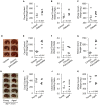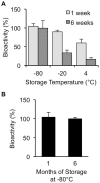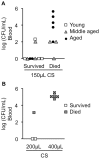A new cecal slurry preparation protocol with improved long-term reproducibility for animal models of sepsis
- PMID: 25531402
- PMCID: PMC4274114
- DOI: 10.1371/journal.pone.0115705
A new cecal slurry preparation protocol with improved long-term reproducibility for animal models of sepsis
Abstract
Sepsis, a life-threatening systemic inflammatory response syndrome induced by infection, is widely studied using laboratory animal models. While cecal-ligation and puncture (CLP) is considered the gold standard model for sepsis research, it may not be preferable for experiments comparing animals of different size or under different dietary regimens. By comparing cecum size, shape, and cecal content characteristics in mice under different experimental conditions (aging, diabetes, pancreatitis), we show that cecum variability could be problematic for some CLP experiments. The cecal slurry (CS) injection model, in which the cecal contents of a laboratory animal are injected intraperitoneally to other animals, is an alternative method for inducing polymicrobial sepsis; however, the CS must be freshly prepared under conventional protocols, which is a major disadvantage with respect to reproducibility and convenience. The objective of this study was to develop an improved CS preparation protocol that allows for long-term storage of CS with reproducible results. Using our new CS preparation protocol we found that bacterial viability is maintained for at least 6 months when the CS is prepared in 15% glycerol-PBS and stored at -80°C. To test sepsis-inducing efficacy of stored CS stocks, various amounts of CS were injected to young (4-6 months old), middle-aged (12-14 months old), and aged (24-26 months old) male C57BL/6 mice. Dose- and age-dependent mortality was observed with high reproducibility. Circulating bacteria levels strongly correlated with mortality suggesting an infection-mediated death. Further, injection with heat-inactivated CS resulted in acute hypothermia without mortality, indicating that CS-mediated death is not due to endotoxic shock. This new CS preparation protocol results in CS stocks which are durable for freezing preservation without loss of bacterial viability, allowing experiments to be performed more conveniently and with higher reproducibility than before.
Conflict of interest statement
Figures







References
-
- Angus DC, van der Poll T (2013) Severe sepsis and septic shock. N Engl J Med 369:2063. - PubMed
-
- Dejager L, Pinheiro I, Dejonckheere E, Libert C (2011) Cecal ligation and puncture: the gold standard model for polymicrobial sepsis? Trends Microbiol 19:198–208. - PubMed
-
- Wichterman KA, Baue AE, Chaudry IH (1980) Sepsis and septic shock–a review of laboratory models and a proposal. J Surg Res 29:189–201. - PubMed
-
- Hubbard WJ, Choudhry M, Schwacha MG, Kerby JD, Rue LW 3rd, et al. (2005) Cecal ligation and puncture. Shock 24 Suppl 152–57. - PubMed
Publication types
MeSH terms
Grants and funding
LinkOut - more resources
Full Text Sources
Other Literature Sources
Medical
Miscellaneous

